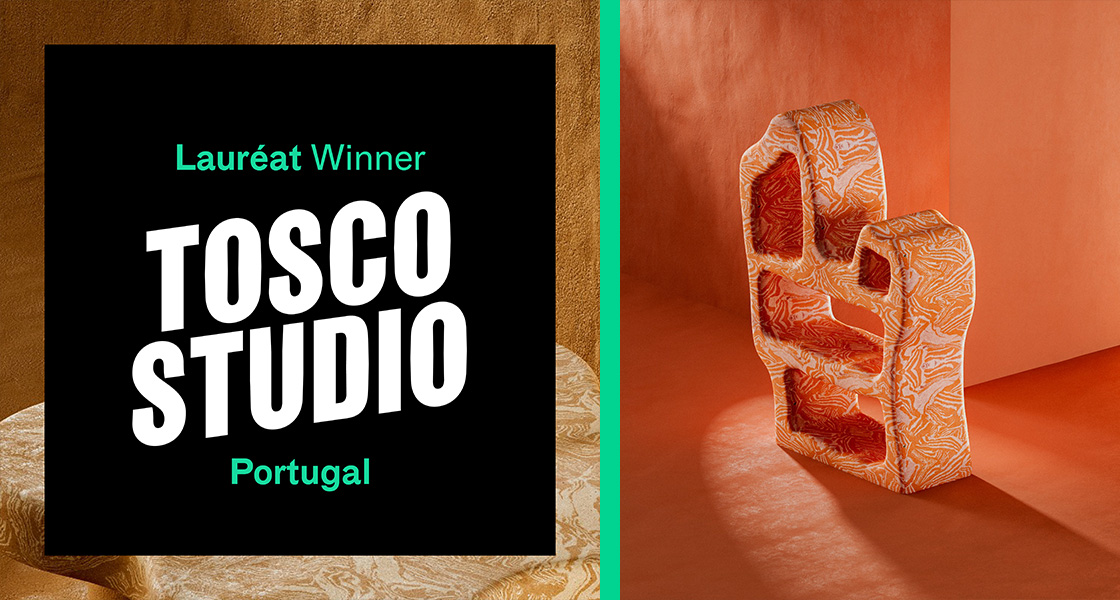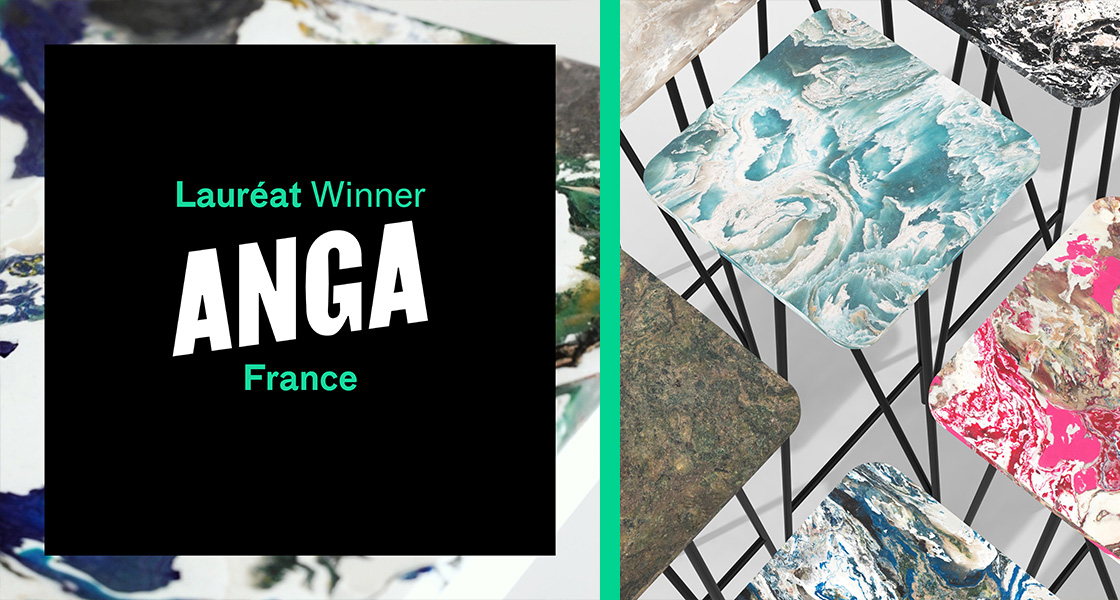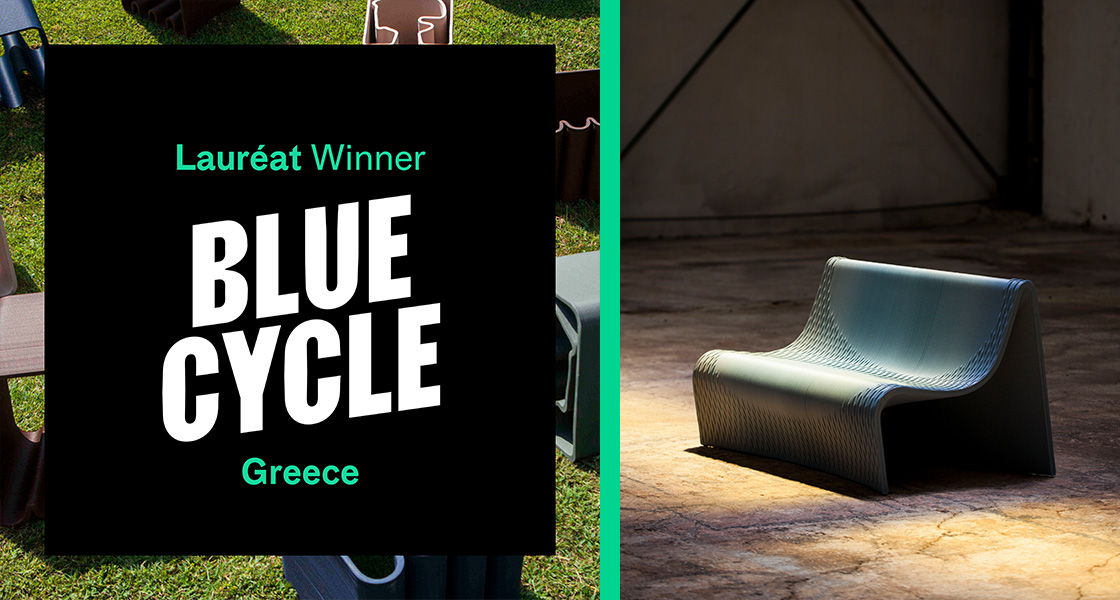Maison&Objet Future On Stage: AND THE BRAND NEW BRANDS ARE…
Published on 6 December 2023

Among the ever-increasing number and ever-more international profile of candidates, the expert panel for the fourth edition of Future on Stage will recognize the marvelous projects of Tosco Studio, Anga, and BlueCycle. These young Portuguese, French, and Greek firms await your discovery at the FOS pavilion from January 18-22, 2024. And what do they have in common? They are all light-years ahead in terms of innovation, business, and creativity.

TOSCO STUDIO
What is it? Unique objects made out of “green” concrete.
Made in: Lisbon.
The brand story: In Alcântara, a trendy part of Lisbon, you’ll find a warehouse scattered with stones, sketches, and pigments. Among them are the tables, vases, and shelving that Joana Esteves has been designing since 2019, out of concrete. “We have a highly standardized mentality in terms of how we use concrete”, Joana explains. “My goal is to prove that it can be noble, fine, and beautiful.” A fan of the architect Gaudí, this artist/designer, who studied sculpture and design at Fine Arts school, thinks in terms of “artworks” rather than “objects”. The countertops, sinks, tiles, and lighting from Tosco Studio are therefore the product of a heavy-duty material that nevertheless seems light as air, both strong and fragile, raw and polished, curved into two-toned marbling that takes on nature-inspired shapes with fluid grace.
Before she transformed construction cement into organic design, surrounded by a team of five people, Joana Esteves worked in an advertising firm for six years. Looking to leave office life behind for a more manual trade, she was exploring a variety of artisanal techniques when an architect friend mentioned cement. It was a light-bulb moment. Though it may have a bad reputation in terms of carbon emissions, concrete is the most-used material in the world. “So, we need to make it better! We work with a cement factory that’s developing less-polluting formulas. We reuse wastewater, recover rocks that are thrown away by construction companies, and recycle our pieces into terrazzo aggregate.” Eureka! Tosco Studio’s client base is already expanding into Spain, France, Italy, the US, and Canada.
The innovative idea: Making cement noble and giving it a “green” touch.
The star product: The tabletops for high and coffee tables in soft, Pop-inspired shapes: flowers, banana splits, or vinyl records.
THE INTERVIEW
How is Tosco Studio revolutionary?
Joana Esteves: The point of my research was to find a material that would allow me total freedom to work with shapes and colors. It took me a while. After many tests, I purchased a bag of concrete. It was a true revelation! I was able to fully express myself and play endlessly with shapes to obtain unusual results and unique effects. Giving suppleness and finesse to a material that was previously used only for major construction work was a creative and technical challenge, through which I hope to have “de-standardized” our mindsets just a bit.
What are you preparing for the Future On Stage pavilion?
JE: We’re going to be showing Tosco’s iconic coffee tables and a few brand-new shelving units. We’re trying out some new tone-on-tone motifs where marbled patterns will be mixed with solid colors. And I already know from working on the pieces that we want to present at Maison&Objet Paris that we’ll be finding new ideas!
What’s next?
JE: We have a number of challenges underway with projects that are awaiting approval, for shelving systems, table designs, and new finishes in our mix of colors and motifs. When we post our new products on Instagram, we receive excellent feedback, and this encourages us to keep innovating!
toscostudio.com

ANGA
What is it? High-end panels made from PEBD.
Made in: Ile de France.
The brand story: Like everyone else, Alexandre Alimi has tripped over floating plastic bags. Except that this former student from the Strate Design school had the idea to make it the raw material for his designs. By melting this outdated waste product (which is badly recycled, or not at all) in his kitchen oven, he discovered that the fine, stretchable film became extremely durable. He partnered with Valentine d’Harcourt, a student from ESSEC, and shifted from making objects to construction panels. Relatively non-toxic, volatile plastic (PEBD) represents around 40% of global production; recycling plants are full of it. “We found untapped sources of it, such as waste from event production, for example”, Valentine explains. Recovered throughout the Ile de France region and processed in Villeneuve Saint-Georges near Orly, this used plastic film is viewed through the lens of the Hindu premise of “Anga”: “Perceive objects (…) just as they are.”
Whether it’s in furniture (tables), interior design (countertops), or installation design (wall or floor coverings), the value of something that previously had none was revealed thanks to the expert skill of a team of six people. Set in a mold according to the desired shade of color, these materials are melted down to form a paste that is pressed and creates uniquely marbled motifs. And so, since 2020, the “volcanic” and “natural” ranges have been created, and the demand is such that Anga has had to scale up industrially to keep pace with the level of orders coming in.
The innovative idea: Creating 21st-century sustainable “marble” by ignoring the prejudices against plastic waste.
The star product: The Dune tabletop in beige and white and “Terre de lave” (Lava earth) in black and white. These are two items that will be produced on an industrial scale to create some inventory.
The buzz factor: Selected for the “Top 30 Under 30” list in Forbes magazine, Anga is making waves internationally as one of the most innovative start-ups in the world.
THE INTERVIEW
How is Anga revolutionary?
Valentine d’Harcourt: Alexandre Alimi obtained the recipe for a revolutionary material that we present as a form of sustainable marble. We’ve managed to combine a high-end aesthetic for the staging or luxury markets while remaining technically proficient and coherent in terms of pricing. We offer panels for countertops, credenzas, or office and bathroom surfaces. Our vocation is to reveal the aesthetic, economic, and technical value of what was initially neglected and considered a burden. Without looking for something fine or noble, we discovered a marvelous surprise!
What are you preparing for the Future On Stage pavilion?
VdH: Unique and colorful large tabletops that we will have specially made for the occasion, and tabletops featuring more classic details. We will also be showing the office furniture we’re in the process of creating with Moore Design.
What’s next?
VdH: In March 2024, we will be renovating rooms at the Villa Médicis using a marble-immersion concept. Today, our technical capabilities allow us to make 130 x 130 cm panels, ranging from 8 to 20 mm thick. Our new goal is to produce 2.5 or even 3 m-long partitions. The challenge will be to take things further in terms of thickness and material density while preserving our beautiful motifs.
anga.fr

BLUECYCLE
What is it? 3D objects made from marine waste.
Made in: Athens.
The brand story: BlueCycle represents a virtuous cycle connected to the sea. It offers furniture in shapes and textures inspired by sea life and made from marine plastic waste. These 3D-printed vases, benches, chairs, and baskets breathe new life into fishing nets and marine expedition materials recovered from the Aegean Sea, directly from the port of Athens or from 30 collection points throughout Greece. Suzanna Laskaridis, its founder, recalls that “as an Athenian, tons of fishing nets have always been part of the landscape. Piraeus is the number-one port in Greece, which itself possesses the biggest fishing grounds in Europe. My first step was to clean up the sea and its islands.” It was only a few years later, in 2020, when she was looking to reintroduce this plastic into the industrial cycle, that she founded BlueCycle. “A problem provides an opportunity to look for solutions, and so, to invent them.”
Eight employees shuttle between the 3D print lab and the traditional manufacturing lab. “In the 3D studio, we can do everything that traditional methods don’t allow us to do, and the most interesting thing for me is to combine the two methods. With the scraps from printing, we make terrazzo, and with this terrazzo, we’re going to…stay tuned to find out!” Also a fan of their design aesthetic that has emerged from robotics, Dutch studio The New Raw is diving in alongside BlueCycle for a long-term collaboration.
The innovative idea: Transforming fishing materials into 100% circular design.
The star product: The Ermis chair, a monolithic seating unit that features simple, ergonomic lines. It’s made robotically using a single spiraled plastic thread that follows geometry and creates a unique graphic texture over its surface.
The buzz factor: They’ve received a considerable amount of media coverage and two Green Awards in 2021. A fabulous, mysterious, and enveloping shell enthralled the presentation for the Louis Vuitton fine jewelry collection in June.
THE INTERVIEW
How is BlueCycle revolutionary?
Suzanna Laskaridis: Possessing an object that gives something back to the planet is so reassuring. I’m sure that there’s a scientific solution for everything. We just have to take the time to think about it. After transforming old nets into pots or outdoor seating, we’ve prepared a homeware series that will be proof of our new research: we’ve just discovered a technique to combine our own waste with two other materials.
What are you preparing for the Future On Stage pavilion?
SL: We will be presenting our future series of objects for the home, in partnership with The New Raw. Well, we hope so, because it’ll have to be completed in time!
What’s next?
SL: We’re currently working on a new series that will combine 3D printing with terrazzo derived from it, plus a third technique that I prefer not to reveal for the moment. We’ll see what we come up with. It seems truly promising.
bluecycle.com